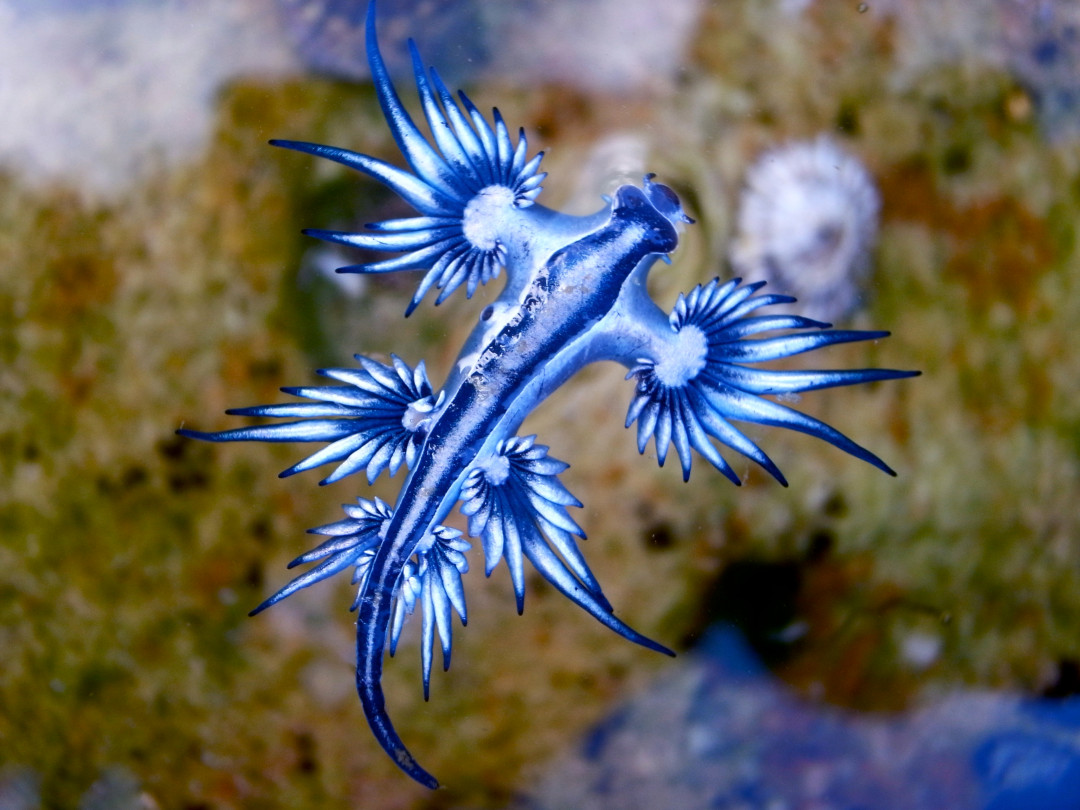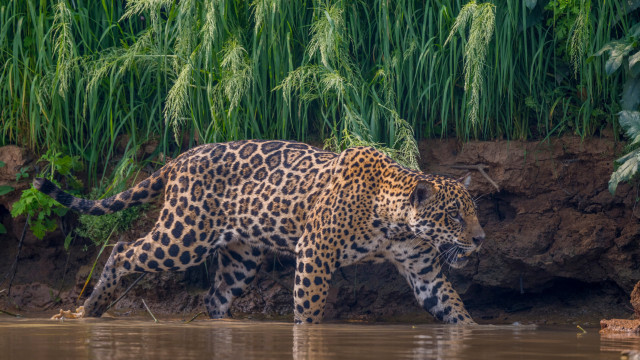







































© Getty Images
0 / 40 Fotos
Axolotl - The animators at Disney/Pixar couldn't have designed a more comical creature. Actually known as the Mexican salamander, or Mexican walking fish, it resembles a slightly neglected rag doll.
© Shutterstock
1 / 40 Fotos
Black snub-nosed monkey - The most peculiar thing about this primate, besides its nose, is its big lips. They can be found in the south of China, as well as Vietnam and Myanmar.
© Shutterstock
2 / 40 Fotos
Maned wolf - Found in South America, this wolf has long, thin legs that distinguish it from all the others of its genus.
© Shutterstock
3 / 40 Fotos
Pacu
- A bite much, isn't it? Even though this toothed fish is a relative of the fearsome piranha, its not-so-pearly whites are quite harmless. In fact, it feeds on aquatic vegetation, snails, and fallen nuts.
© Shutterstock
4 / 40 Fotos
Amazonian royal flycatcher - This beautiful species of bird, with a bright headdress-like plume of feathers, is found in regions of South America.
© Shutterstock
5 / 40 Fotos
Grimpoteuthis - Nicknamed the Dumbo octopus in a nod to Disney's flying elephant, this extraordinary-looking animal has a pair of protruding ear-like fins attached to its head, and is armed with eight tentacles.
© Public Domain
6 / 40 Fotos
Saiga - This species of antelope, with a flexible nose similar to that of an elephant, is under threat of extinction. It has been found in parts of Mongolia, as well as other areas of Asia and Africa.
© Shutterstock
7 / 40 Fotos
Star-nosed mole - The nose of this mole species is definitely weird looking, but it serves an important purpose. Moles have terrible vision, so the nose helps them to feel things.
© Shutterstock
8 / 40 Fotos
Venezuelan poodle moth - This species of moth is found in Venezuela, and it especially intrigued scientists because of its furry legs.
© Shutterstock
9 / 40 Fotos
Red-lipped batfish
- This curious animal looks like it's ready for a night out. Native to the Galapagos Islands, this species is also known for being able to "walk" on the seabed, using its fins as extra pairs of legs.
© Shutterstock
10 / 40 Fotos
Jerboa - This tiny, jumping rodent can be found in China, Mongolia, and northeastern Africa.
© Shutterstock
11 / 40 Fotos
Mantis shrimp - This colorful crustacean is one of the most intriguing animals in the world. The small beady-eyed creature is actually an accomplished predator, and literally clubs its prey to death.
© Shutterstock
12 / 40 Fotos
Shoebill - Also known as a whalehead stork, this bird has some similar characteristics to a stork and a toucan, and can be found in Sudan and Zambia.
© Shutterstock
13 / 40 Fotos
Aye-aye
- This tiny nocturnal primate is native to Madagascar. Besides a fun name and an over-caffeinated look, it also has one finger that is longer than the others to better reach the larvae in the holes of trees.
© Shutterstock
14 / 40 Fotos
Lowland streaked tenrec - This species of mammal, similar to a hedgehog, can be found in the tropical forests of Madagascar. It is the only mammal that uses stridulation to generate sound, similar to that of a rattlesnake.
© Shutterstock
15 / 40 Fotos
Fossa
- This carnivorous mammal, resembling a cross between a cat and a hyena, can be found on the island of Madagascar.
© Shutterstock
16 / 40 Fotos
Thorny devil
- This small reptile sports a coat of ridges and spines, is around 20 cm (less than 8 in) in length and lives in Australia. Though it seems quite tough, it actually just eats ants.
© Shutterstock
17 / 40 Fotos
Colugo - This mammal gets as close to flying as mammals can, with flaps of skin like wings. Colugos can be found in Southeast Asia.
© Shutterstock
18 / 40 Fotos
Lamprey - Lampreys are freshwater fish, similar to eels, just with mouths that resemble a terrifying sea monster.
© Shutterstock
19 / 40 Fotos
Blue sea slug - Also referred to as "blue dragon" for its ultramarine hue and fan-like wings, this species measures just 4 cm (1.5 in) in length, and swims in a vertical position.
© Shutterstock
20 / 40 Fotos
Mara - This rodent shares some physical characteristics with a hare, but with longer legs. It can be found in South America.
© Shutterstock
21 / 40 Fotos
Gerenuk - This African animal is, perhaps unsurprisingly, also known as the giraffe gazelle—though it is not directly related to either.
© Shutterstock
22 / 40 Fotos
Pink fairy armadillo - True to its name, this is one of the rarest mammals in the world, and is only found in Argentina.
© Public Domain
23 / 40 Fotos
Babirusa - This animal looks like a cross between a pig and a rhinoceros, and is found on the Indonesian Islands.
© Shutterstock
24 / 40 Fotos
Tapir - This bulky, herbivorous mammal is similar in shape to a pig, but has a short, prehensile nose trunk. It is found broadly in regions of Central and South America, and Southeastern Asia.
© Shutterstock
25 / 40 Fotos
Honduran white bat - When you see it curled up in the distance, this palm-sized bat resembles an adorable ball of cotton. Found only in Central America, it feeds on vegetation and fruit.
© Shutterstock
26 / 40 Fotos
Philippine tarsier - If any creature can out-stare you, it's this bug-eyed, tree-hugging primate that seems to be in permanent shock. One of the smallest primates in the world, it weighs around 140 g (less than 5 oz), and stands just 15 cm (5.9 in) tall.
© Shutterstock
27 / 40 Fotos
Tube-nosed fruit bat - This strange-looking bat, hidden in the jungles of New Guinea, has many odd features, but the most pronounced is definitely its protruding nostrils.
© Shutterstock
28 / 40 Fotos
Hummingbird hawk-moth - Hovering to feed, this handsome moth resembles its namesake in flight and even in sound. It loves nectar-rich flowers.
© Shutterstock
29 / 40 Fotos
Okapi - Zebras aren't the only ones who wear stripes! This curious mammal is native to the Democratic Republic of Congo.
© Shutterstock
30 / 40 Fotos
Panda ant
- Actually a wingless wasp, this striking but minuscule creepy crawly is named for its black and white pattern reminiscent of a panda's coat. It can be found in Chile, Argentina, and certain regions of Mexico.
© Shutterstock
31 / 40 Fotos
Dugong - This species of marine mammal, also known as the sea cow, can be found in tropical regions of the Indian and Pacific Oceans. The dugong can grow to be nearly 3 m (9.8 ft) long, and weigh around 300 kg (660 lbs).
© Shutterstock
32 / 40 Fotos
Salp
- This organism consists of a transparent, gelatinous body. It's a slimy sludge of life that sustains itself by pumping water through its internal feeding filters. It doesn't get much simpler than this!
© Shutterstock
33 / 40 Fotos
Red handfish
- Discovered in waters by Tasmania, this fish simply can't be bothered to swim. Instead, it uses its rose-colored pectoral and pelvic fins to walk across the seabed.
© Getty Images
34 / 40 Fotos
Elephant shrew - This native African mammal has a long snout, hence its name.
© Shutterstock
35 / 40 Fotos
Irrawaddy dolphin - This species of dolphin can be found in coastal regions of Asia. It lacks the long snout characteristic of the dolphins we are used to seeing.
© Shutterstock
36 / 40 Fotos
Giant isopod - This nightmarish species was found in the Gulf of Mexico in 2002, though it is believed to be extinct.
© Shutterstock
37 / 40 Fotos
Pinocchio frog - Discovered recently in Indonesia, this rare amphibian has the ability to enlarge and inflate its nose, though it always remains down when the animal is calm and quiet.
© Reuters
38 / 40 Fotos
Ili pika
- Endemic to the northwestern region of China, this endangered rare animal is known as the "magic rabbit," and lives at high altitude, anywhere between 2,800 and 4,100 meters (9,190 to 13,450 ft). See also: These baby animals look nothing like their parents.
© Shutterstock
39 / 40 Fotos
© Getty Images
0 / 40 Fotos
Axolotl - The animators at Disney/Pixar couldn't have designed a more comical creature. Actually known as the Mexican salamander, or Mexican walking fish, it resembles a slightly neglected rag doll.
© Shutterstock
1 / 40 Fotos
Black snub-nosed monkey - The most peculiar thing about this primate, besides its nose, is its big lips. They can be found in the south of China, as well as Vietnam and Myanmar.
© Shutterstock
2 / 40 Fotos
Maned wolf - Found in South America, this wolf has long, thin legs that distinguish it from all the others of its genus.
© Shutterstock
3 / 40 Fotos
Pacu
- A bite much, isn't it? Even though this toothed fish is a relative of the fearsome piranha, its not-so-pearly whites are quite harmless. In fact, it feeds on aquatic vegetation, snails, and fallen nuts.
© Shutterstock
4 / 40 Fotos
Amazonian royal flycatcher - This beautiful species of bird, with a bright headdress-like plume of feathers, is found in regions of South America.
© Shutterstock
5 / 40 Fotos
Grimpoteuthis - Nicknamed the Dumbo octopus in a nod to Disney's flying elephant, this extraordinary-looking animal has a pair of protruding ear-like fins attached to its head, and is armed with eight tentacles.
© Public Domain
6 / 40 Fotos
Saiga - This species of antelope, with a flexible nose similar to that of an elephant, is under threat of extinction. It has been found in parts of Mongolia, as well as other areas of Asia and Africa.
© Shutterstock
7 / 40 Fotos
Star-nosed mole - The nose of this mole species is definitely weird looking, but it serves an important purpose. Moles have terrible vision, so the nose helps them to feel things.
© Shutterstock
8 / 40 Fotos
Venezuelan poodle moth - This species of moth is found in Venezuela, and it especially intrigued scientists because of its furry legs.
© Shutterstock
9 / 40 Fotos
Red-lipped batfish
- This curious animal looks like it's ready for a night out. Native to the Galapagos Islands, this species is also known for being able to "walk" on the seabed, using its fins as extra pairs of legs.
© Shutterstock
10 / 40 Fotos
Jerboa - This tiny, jumping rodent can be found in China, Mongolia, and northeastern Africa.
© Shutterstock
11 / 40 Fotos
Mantis shrimp - This colorful crustacean is one of the most intriguing animals in the world. The small beady-eyed creature is actually an accomplished predator, and literally clubs its prey to death.
© Shutterstock
12 / 40 Fotos
Shoebill - Also known as a whalehead stork, this bird has some similar characteristics to a stork and a toucan, and can be found in Sudan and Zambia.
© Shutterstock
13 / 40 Fotos
Aye-aye
- This tiny nocturnal primate is native to Madagascar. Besides a fun name and an over-caffeinated look, it also has one finger that is longer than the others to better reach the larvae in the holes of trees.
© Shutterstock
14 / 40 Fotos
Lowland streaked tenrec - This species of mammal, similar to a hedgehog, can be found in the tropical forests of Madagascar. It is the only mammal that uses stridulation to generate sound, similar to that of a rattlesnake.
© Shutterstock
15 / 40 Fotos
Fossa
- This carnivorous mammal, resembling a cross between a cat and a hyena, can be found on the island of Madagascar.
© Shutterstock
16 / 40 Fotos
Thorny devil
- This small reptile sports a coat of ridges and spines, is around 20 cm (less than 8 in) in length and lives in Australia. Though it seems quite tough, it actually just eats ants.
© Shutterstock
17 / 40 Fotos
Colugo - This mammal gets as close to flying as mammals can, with flaps of skin like wings. Colugos can be found in Southeast Asia.
© Shutterstock
18 / 40 Fotos
Lamprey - Lampreys are freshwater fish, similar to eels, just with mouths that resemble a terrifying sea monster.
© Shutterstock
19 / 40 Fotos
Blue sea slug - Also referred to as "blue dragon" for its ultramarine hue and fan-like wings, this species measures just 4 cm (1.5 in) in length, and swims in a vertical position.
© Shutterstock
20 / 40 Fotos
Mara - This rodent shares some physical characteristics with a hare, but with longer legs. It can be found in South America.
© Shutterstock
21 / 40 Fotos
Gerenuk - This African animal is, perhaps unsurprisingly, also known as the giraffe gazelle—though it is not directly related to either.
© Shutterstock
22 / 40 Fotos
Pink fairy armadillo - True to its name, this is one of the rarest mammals in the world, and is only found in Argentina.
© Public Domain
23 / 40 Fotos
Babirusa - This animal looks like a cross between a pig and a rhinoceros, and is found on the Indonesian Islands.
© Shutterstock
24 / 40 Fotos
Tapir - This bulky, herbivorous mammal is similar in shape to a pig, but has a short, prehensile nose trunk. It is found broadly in regions of Central and South America, and Southeastern Asia.
© Shutterstock
25 / 40 Fotos
Honduran white bat - When you see it curled up in the distance, this palm-sized bat resembles an adorable ball of cotton. Found only in Central America, it feeds on vegetation and fruit.
© Shutterstock
26 / 40 Fotos
Philippine tarsier - If any creature can out-stare you, it's this bug-eyed, tree-hugging primate that seems to be in permanent shock. One of the smallest primates in the world, it weighs around 140 g (less than 5 oz), and stands just 15 cm (5.9 in) tall.
© Shutterstock
27 / 40 Fotos
Tube-nosed fruit bat - This strange-looking bat, hidden in the jungles of New Guinea, has many odd features, but the most pronounced is definitely its protruding nostrils.
© Shutterstock
28 / 40 Fotos
Hummingbird hawk-moth - Hovering to feed, this handsome moth resembles its namesake in flight and even in sound. It loves nectar-rich flowers.
© Shutterstock
29 / 40 Fotos
Okapi - Zebras aren't the only ones who wear stripes! This curious mammal is native to the Democratic Republic of Congo.
© Shutterstock
30 / 40 Fotos
Panda ant
- Actually a wingless wasp, this striking but minuscule creepy crawly is named for its black and white pattern reminiscent of a panda's coat. It can be found in Chile, Argentina, and certain regions of Mexico.
© Shutterstock
31 / 40 Fotos
Dugong - This species of marine mammal, also known as the sea cow, can be found in tropical regions of the Indian and Pacific Oceans. The dugong can grow to be nearly 3 m (9.8 ft) long, and weigh around 300 kg (660 lbs).
© Shutterstock
32 / 40 Fotos
Salp
- This organism consists of a transparent, gelatinous body. It's a slimy sludge of life that sustains itself by pumping water through its internal feeding filters. It doesn't get much simpler than this!
© Shutterstock
33 / 40 Fotos
Red handfish
- Discovered in waters by Tasmania, this fish simply can't be bothered to swim. Instead, it uses its rose-colored pectoral and pelvic fins to walk across the seabed.
© Getty Images
34 / 40 Fotos
Elephant shrew - This native African mammal has a long snout, hence its name.
© Shutterstock
35 / 40 Fotos
Irrawaddy dolphin - This species of dolphin can be found in coastal regions of Asia. It lacks the long snout characteristic of the dolphins we are used to seeing.
© Shutterstock
36 / 40 Fotos
Giant isopod - This nightmarish species was found in the Gulf of Mexico in 2002, though it is believed to be extinct.
© Shutterstock
37 / 40 Fotos
Pinocchio frog - Discovered recently in Indonesia, this rare amphibian has the ability to enlarge and inflate its nose, though it always remains down when the animal is calm and quiet.
© Reuters
38 / 40 Fotos
Ili pika
- Endemic to the northwestern region of China, this endangered rare animal is known as the "magic rabbit," and lives at high altitude, anywhere between 2,800 and 4,100 meters (9,190 to 13,450 ft). See also: These baby animals look nothing like their parents.
© Shutterstock
39 / 40 Fotos
Weird and wonderful animals you've never heard of
From the hilariously absurd to the strangely terrifying
© Getty Images
We often grow up learning about the same popular animals (lions, elephants, dogs, monkeys, etc.), but there are so many underappreciated species that are left behind! Spread across the four corners of the Earth are strange and intriguing creatures that often exceed our imagination, exhibiting shapes and colors that only Mother Nature could design. Especially the creature voted the earth's most hideous species...
Click through for a thorough introduction to the world's weirdest and most wonderful animals.
RECOMMENDED FOR YOU




































MOST READ
- Last Hour
- Last Day
- Last Week








